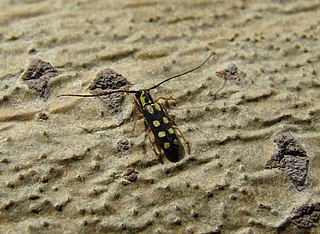
The longhorn beetles (Cerambycidae), also known as long-horned or longicorns, are a large family of beetles, with over 35,000 species described.

A woodworm is the wood-eating larva of many species of beetle. It is also a generic description given to the infestation of a wooden item by these larvae.

Polyphaga is the largest and most diverse suborder of beetles. It comprises 144 families in 16 superfamilies, and displays an enormous variety of specialization and adaptation, with over 350,000 described species, or approximately 90% of the beetle species discovered thus far.

The Chrysomeloidea are an enormous superfamily of beetles, with tens of thousands of species. The largest families are Cerambycidae, long-horned beetles, with more than 35,000 species, and Chrysomelidae, leaf beetles, with more than 13,000 species.

Tritoma is a genus of beetles in the family Erotylidae, the pleasing fungus beetles. It is distributed worldwide, mainly in the Old World. There are over 100 species.

The term woodboring beetle encompasses many species and families of beetles whose larval or adult forms eat and destroy wood. In the woodworking industry, larval stages of some are sometimes referred to as woodworms. The three most species-rich families of woodboring beetles are longhorn beetles, bark beetles and weevils, and metallic flat-headed borers. Woodboring is thought to be the ancestral ecology of beetles, and bores made by beetles in fossil wood extend back to the earliest fossil record of beetles in the Early Permian (Asselian), around 295-300 million years ago.

Moneilema, or cactus longhorn beetles are a genus of large, flightless, black beetles found in North American deserts of the western United States and northern Mexico. M. gigas is native to the Sonoran Desert at elevations below 4900 feet (1500m). The front wings of these beetles are fused forming a single, hardened shell, from which the genus derives its Latin name. The genus includes twenty species.

The valley elderberry longhorn beetle is a subspecies of longhorn beetle native to the riparian forests of the Central Valley of California from Redding to Bakersfield. It is listed as a federally threatened species; a proposal to delist the insect was withdrawn in 2014.

Xylotoles costatus, the Pitt Island longhorn beetle, is a species of beetle in the family Cerambycidae. It is endemic to the Chatham Islands. Once thought to be extinct, it is now known to survive on South East Island/Rangatira; being therefore an example of a so-called "Lazarus taxon".

Adalia decempunctata, the ten-spotted ladybird or ten-spotted lady beetle, is a carnivorous beetle of the family Coccinellidae.

Stenotrachelidae, commonly called false longhorn beetles is a family of beetles in the superfamily Tenebrionoidea. They are native to the Northern Hemisphere. The larvae feed on heavily decomposed wood, while the adults are likely short lived and probably feed on pollen.
Mordellistena bipustulata is a beetle in the genus Mordellistena of the family Mordellidae. It was described in 1864 by Helmuth.

Tetropium fuscum, the brown spruce longhorn beetle, is a species of beetle in the family Cerambycidae. It was described by Johan Christian Fabricius in 1787. Tetropium fuscum is native to Europe and Northern Asia, and has been introduced to Nova Scotia, Canada. Brown spruce longhorn is a pest of spruce trees.

Parmenini is a tribe of longhorn beetles of the subfamily Lamiinae.
Clivina bipustulata is a species of ground beetle in the subfamily Scaritinae. It was described by Johan Christian Fabricius in 1801.
Dmytro Zajciw was a Ukrainian and Brazilian entomologist, notable for his many beetle discoveries and for his collection. He was born in Velyka Mykhailivka, Ukraine and died in Rio de Janeiro, Brazil. He was the author of Two new genera and species of neotropical Longhorn beetles , 1957, Contribution to the study of Longhorn beetles of Rio de Janeiro , 1958, and was the first to describe the genera Adesmoides and Pseudogrammopsis, as well as the species Beraba angusticollis and Mionochroma subaurosum, among many others.

Menesia sulphurata is a species of beetle in the family Cerambycidae. It was described by Gebler in 1825, originally under the genus Saperda. It is known from Mongolia, Kazakhstan, Japan, China, and Russia.

Dacne bipustulata is a species of pleasing fungus beetles native to Europe.

Paraclivina bipustulata is a species of ground beetle in the family Carabidae. It is found in the Caribbean, Central America, and North America.
Phyllotreta bipustulata, the woodland flea beetle, is a species of flea beetle in the family Chrysomelidae. It is found in North America.















